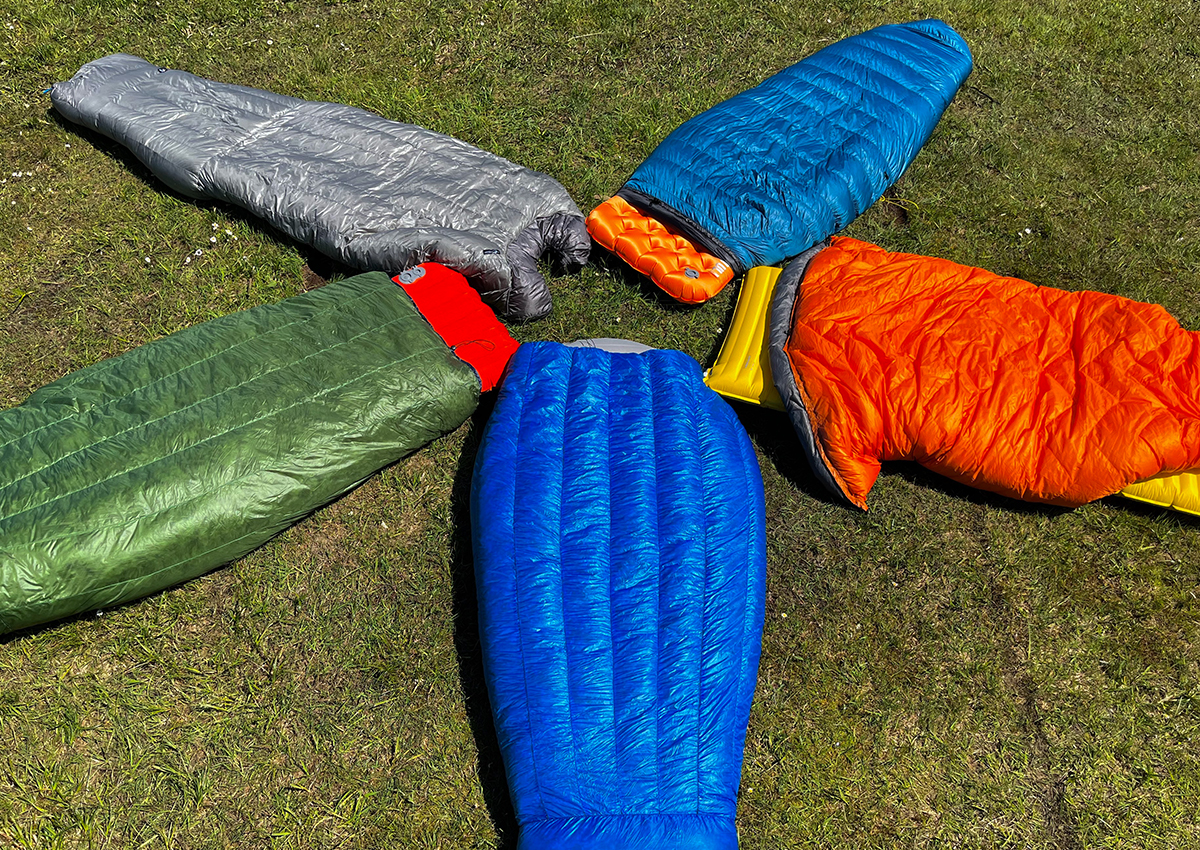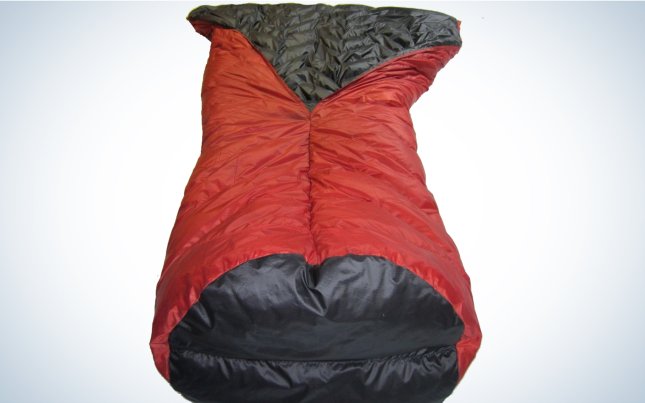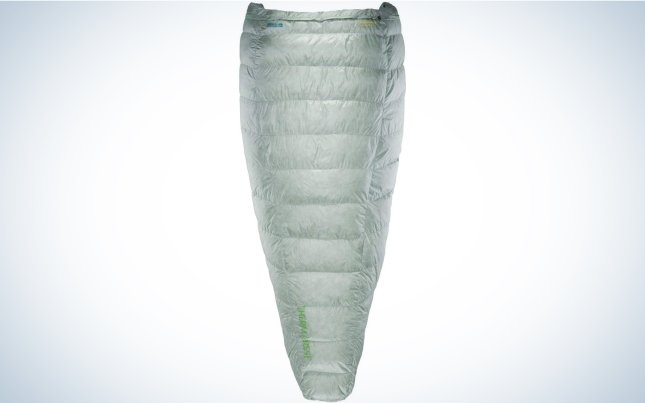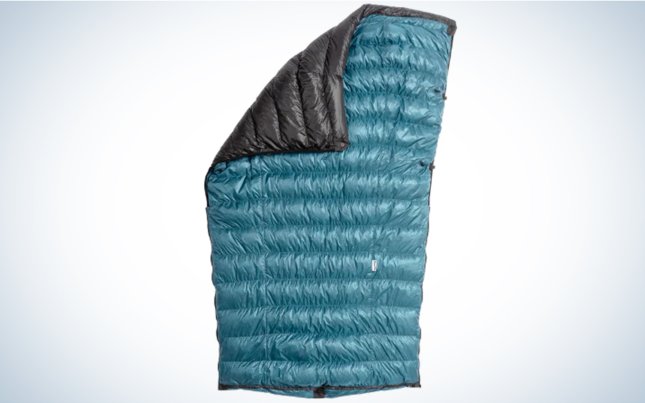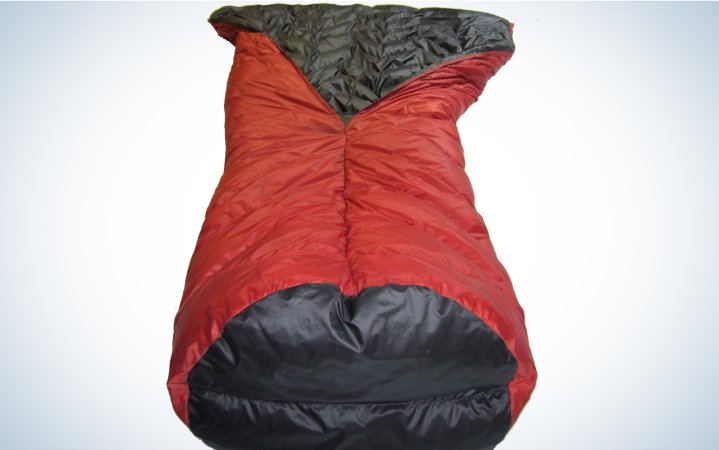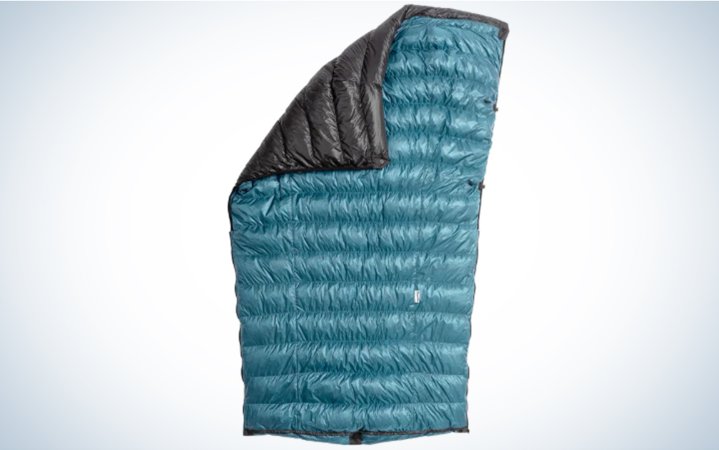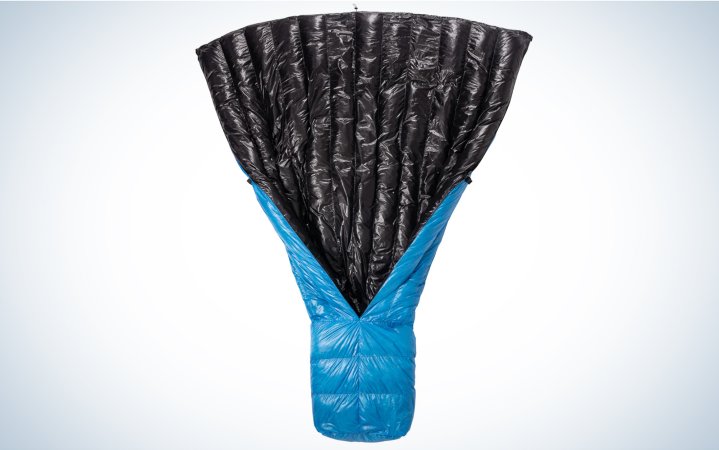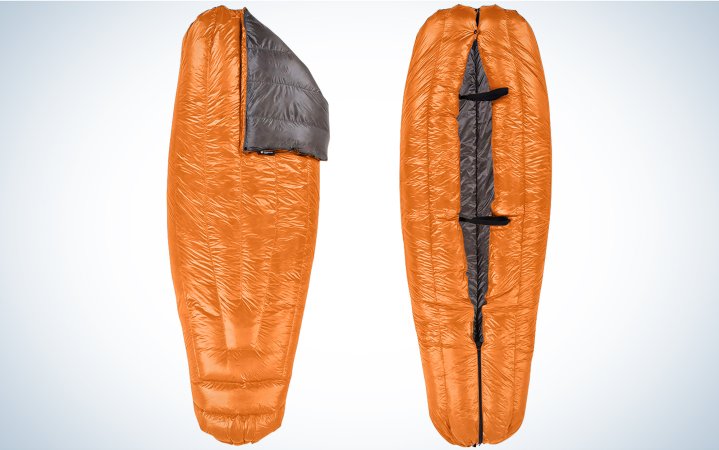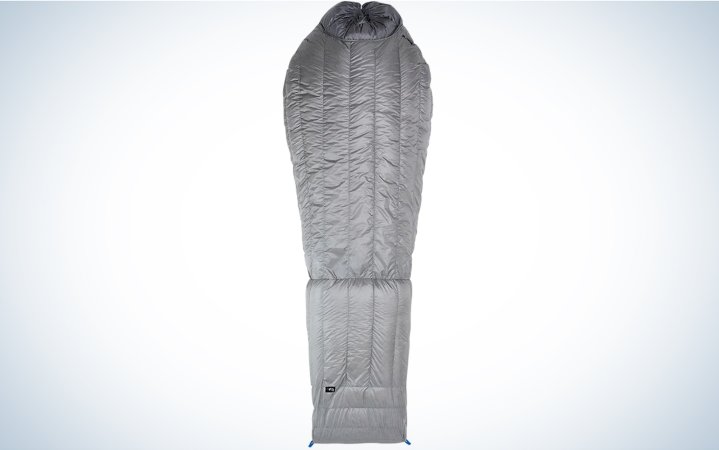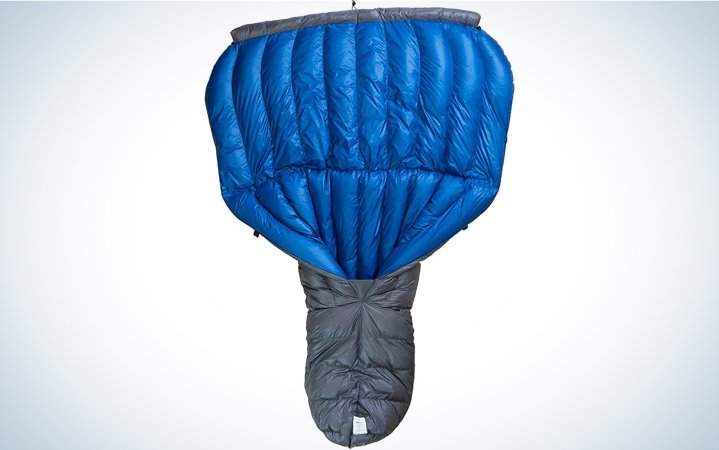We may earn revenue from the products available on this page and participate in affiliate programs. Learn More ›
For years, backpackers and backpack hunters serious about ounce-cutting have looked to ultralight quilts. Unlike sleeping bags, which are enclosed from top to bottom and back to front, quilts are open underneath, saving weight and allowing for greater freedom of movement. To keep you warm they come with enclosed footboxes and straps that hook underneath your sleeping pad, preventing drafts from sneaking in the sides. To find out which of these our group of experienced quilt users (and a couple of skeptics) would take into the field, we tried out seven of the best backpacking quilts as part of our backpacking test on the Oregon Coast Trail.
- Best Overall: Loco Libre Gear Ghost Pepper
- Best for Beginners: Therm-a-Rest Vesper
- Most Versatile: Katabatic Gear Flex
- Lightest: Zpacks Solo Quilt
- Best Customization: Enlightened Equipment Revelation
- Best Features: Stone Glacier Chilkoot
- Best Budget: Outdoor Vitals Stormloft
How We Tested the Best Backpacking Quilts
For this test, five Outdoor Life writers and editors with over 20,000 miles of backpacking experience took seven ultralight quilts to use along a section of the 362-mile Oregon Coast Trail in late April. All of our testers were women; about half of us identified as cold sleepers. Only two of us used quilts as part of our typical backpacking gear setup. One of the testers had never used a quilt before.

The Ultralight Quilts We Tested
We chose quilts from established ultralight manufacturers, including Enlightened Equipment, Katabatic Gear, and Zpacks, as well as ultralight hunt manufacturer Stone Glacier and relative newcomers Outdoor Vitals and Loco Libre. We also brought a quilt from Therm-a-Rest, whose NeoAir Xlite NXT is our pick for the best backpacking sleeping pad. In a previous look at backpacking quilts, I considered the Sea to Summit Ember, but left it off of this test due to known issues with drafts and providing sufficient coverage.
The Conditions
During our testing trip, overnight temperatures dropped into the low 40s. All quilts were tested with a minimum R-rated sleeping pad of 4, including the Therm-a-Rest NeoAir Xlite NXT, Therm-a-Rest NeoAir Xtherm, and Big Agnes Zoom UL. While the insulation ability of sleeping bags will also dramatically decrease without an appropriate R-rated sleeping pad, an ultralight quilt is virtually unusable without one.
For more information on what R value is and why it’s important, click to jump to our section on R value.
It’s worth noting that multiple cold sleepers found that the Therm-a-Rest NeoAir Xtherm sleeping pad, which is advertised as being for “extreme cold backcountry pursuits,” played an essential role in keeping them warm during the sea-level shoulder-season conditions we experienced. If you identify as a cold sleeper or feel that you have been struggling to find a sleeping bag or ultralight quilt that can keep you warm, strongly consider upgrading your sleeping pad to something with a higher R Value.
While we experienced very little rain on this testing trip, we did see some of the worst condensation any of us had ever experienced. You could see droplets of moisture hanging in the air at night with your headlamp; tent walls were soaked within an hour of being set up, without anyone even being inside. As such, the ultralight quilts in our test were exposed to moisture that is well beyond what normal backpackers can expect to experience, which provided insight into which were able to handle more extreme conditions.
Testing Protocol and Grading
Testers swapped out for a new quilt every night, to give us a better sense of how the quilts compared for warmth and functionality, and how different experience levels, body types, and internal thermostats affected our experience. We did our best when assessing the quilts to treat the issue of warmth as separate from comfort and have provided comparative feedback to assist you in choosing the correct temperature rating for your needs from each quilt manufacturer.
Each ultralight quilt was evaluated in four categories and given a score of 1 (poor) to 5 (excellent) from each tester. Warmth was evaluated to determine whether a quilt ran hot or cold compared to others at that same temperature rating to help guide individuals when selecting a temperature rating for themselves. After discussing the scores and relative merits of each ultralight quilt, we then determined and agreed upon the awards as a group. The categories were:
- Ease of set up: How difficult were the straps to use, and did they stay in place overnight?
- Comfort: Did the testers enjoy being inside the quilt, both compared to sleeping bags and other quilts in this test?
- Water Repellency: How did the quilts handle the condensation encountered on the Oregon Coast Trail? Did it affect the loft or overall warmth?
- Value: Ultralight quilts are ultralight because they use high-quality—and expensive—materials. This is an investment—even our budget pick is over three hundred dollars. In addition to price, value was assessed by looking at the warranties, warmth to weight ratio, and overall comfort.
- Warmth: While there is an industry-standard temperature rating test for hooded sleeping bags, there is no independent verification for the temperature rating of a quilt. Manufacturers are using their best judgment, and experience, to make that determination, but—as our test showed—what constitutes a 20-degree quilt from one manufacturer does not necessarily translate to a 20-degree quilt from another. (Further complicating this issue is that some manufacturers are advertising the comfort temperature rating of a quilt, while others are advertising the limit rating). Assuming an individual who runs cold, and treating all quilts as if they were reporting a “limit” rating for comparison’s sake, we provided our feedback on whether you should increase the warmth recommendation for a sleeping bag over manufacturer recommendations.
While we did independently verify the weights of the backpacking quilts as part of this test, we have chosen not to include that information unless the weight (quilt alone, not including stuff sack) is more than an ounce outside of what the manufacturer specifications tell you to expect. This is due to both inconsistencies in the sizing of the quilts that were sent to us (some were larger than others), and because users should expect some natural variation with items being made by hand with natural materials like goose down.
Best Backpacking Quilts: Reviews & Recommendations
Best Overall: Loco Libre Gear Ghost Pepper
Pros
- All three of our quilt skeptics were warm and happy in this quilt, all three nights
- Great customization options, including camo prints
- Chevron baffle design prevents the down from settling better than either vertical or horizontal designs
Cons
- Sleeping pad attachments were less obvious than other models we looked at
Report Card (20-degree quilt tested)
- Ease of Set Up: 4.5
- Comfort: 5
- Water Repellency: 5
- Value: 4
- Runs very warm
Key Features
- Temperature Ratings Options: 0 degrees to 50 degrees
- Fill Power Options: 900 fill power
- Length Options: 65 inches to 85 inches
- Width Options: 52 inches to 55 inches
- Fabric Options: Argon 90 and Argon 67
- Footbox Style: Closed
- 90-day warranty (ongoing repairs available for an additional fee)
We had our three quilt newbs test out the Loco Libre Ghost Pepper, and I’m glad we did because this quilt converted two of them to this sleep system (we’ll keep working on the third one).
Our first night, when temperatures dipped down to 43 degrees, our tester didn’t even strap it to her sleeping pad, just crawled underneath and fell right asleep. She was impressed by just how quickly it warmed up when paired with a Therm-a-Rest NeoAir Xlite, and how warm she stayed overnight—even while tossing and turning so much that a second tester woke up. Part of what kept her so warm is the unique Chevron baffling, which helped prevent the down from shifting out of place. Shifting down can become an issue with vertical and horizontal baffles, resulting in cold spots.

Multiple testers commented that the Argon 90 fabric used was comfortable to their skin, and helped to manage the excessive moisture buildup from the Oregon Coast’s never ending condensation. Even when the footbox of this ultralight quilt was pushed up against the soaking-wet wall of one of the best ultralight tents, our testers’ feet stayed toasty warm.
So what about that lone holdout—the unconverted quilt user? While she was warm all night, she actually found the more spacious design of the Loco Libre Designs Ghost Pepper to be a bit overkill, and ended up missing the more confined feeling of a traditional sleeping bag. If you know you like the security of a sleeping bag, but are curious about trying a quilt, check out our take on the Katabatic Flex.
Best for Beginners: Therm-a-Rest Vesper
Pros
- Under quilt straps don’t need to be adjusted to keep out drafts
- Very lightweight
- Backed by the Therm-a-Rest warranty
Cons
- Most expensive quilt we looked at
- Fewer length and width options than with other quilts we looked at
Report Card (20-degree quilt tested)
- Ease of Set Up: 3.5
- Comfort: 4
- Water Repellency: 4.5
- Value: 3.5
- Runs true to stated temperature rating
- Sample tested was 1.6 ounces heavier than manufacturer specifications
Key Features
- Temperature Ratings Options: 20 degrees to 45 degrees
- Fill Power Options: 900 fill power
- Length Options: 75 inches to 79 inches
- Width Options: 58 inches to 61 inches
- Fabric Options: 10D nylon ripstop
- Footbox Style: Closed
- Lifetime warranty
I didn’t properly explain how to attach backpacking quilts to the sleeping pad for our newbie quilt users the first night out (apologies testers), but fortunately for the person with the Therm-a-Rest Vesper, it didn’t really matter. Despite placing the quilt straps underneath her body (they are supposed to go under the pad), the width of this quilt kept our tester covered—and warm—all night.

Our second tester, an experienced quilt user, also praised the width of this quilt, saying that it allowed her to turn over easily. She was further impressed by how well the straps kept out unwanted drafts. Unlike the other ultralight quilt straps we looked at, there are no adjustments to fiddle with here. These straps stay in place with a light elastic that is connected to a few inches around the outer edge of the quilt. (Other straps in our test were connected right at the edge). This causes the edges of the quilt to curl over, preventing drafts from sneaking in. Testers also praised the skin feel and toasty footbox of the Therm-a-Rest Vesper, although they noted that the button closure at the neck had a tendency to open up when they moved around during the night.

Something unusual about the Therm-a-Rest Vesper is that it incorporates compression straps into its stuff sack design. While this ostensibly allows you to compress your quilt down into the smallest possible package, this compression sack is an ounce heavier than the best-in-class stuff sack that comes with the Zpacks Solo Quilt. We recommend either replacing this or dispensing with the sack entirely and stuffing your quilt loosely at the bottom of one of the best ultralight backpacks.
Most Versatile: Katabatic Gear Flex
Pros
- Longest zip footbox in our test
- Comparatively affordably priced
- Additional clips can be used to block even the most determined drafts
Cons
- Somewhat complicated for first-time quilt users to use
Report Card (22-degree quilt tested)
- Ease of Set Up: 3
- Comfort: 4
- Water Repellency: 4
- Value: 4
- Runs warm
- Sample tested was 1.6 ounces heavier than manufacturer specifications
Key Features
- Temperature Ratings Options: 15 degrees to 30 degrees
- Fill Power Options: 850 fill power or 900 fill power
- Length Options: 64 inches to 76 inches
- Width Options: 54 inches to 58 inches
- Fabric Options: Pertex Quantum Eco Ripstop
- Footbox Style: Convertible
- Limited lifetime warranty
The biggest challenge for any sleep system is that the ambient air temperature is going to be different every time you head into the backcountry. Sometimes you might even get a 20 to 30 degree temperature swing on a single trip; if you’re thru-hiking it might be as high as 50 degrees. The better your ultralight quilt can adapt to a variety of conditions, the better you’re going to sleep.

This is where the Katabatic Gear Flex excelled. It had the longest footbox of any ultralight quilt we looked at to the point that it was almost a quilt–sleeping bag hybrid. But it’s a zipped footbox, so if that feels excessive to you, you can unzip it partially or even all the way so that it’s blanket-shaped. It also has a double-attachment point for the straps that can go under your sleeping pad. These straps attach and lock into place at the edge, like most backpacking quilts, but can be attached at a second point a few inches past that (similar to the single attachment point of the Therm-a-Rest Vesper). This gives you a surprisingly amount of control in cinching up your quilt for maximum warmth, and letting it breathe when temperatures are higher so that you don’t overheat.
This is a bit more complicated to use than the other strap attachments we ran into in our test—it was the only quilt that had (or needed) double-sided instructions to use. It ended up being too complicated for one of our testers (and quilt skeptics), as it turns out. She also felt that this ultralight quilt had more of a “barely there” feel to it than others in our test. If you sleep best with the weight of a blanket on top of your body, this may be an issue for you as well, although we think most ultralight backpackers will read our testers’ feedback as high praise.
Lightest: Zpacks Solo Quilt
Pros
- Lightest quilt in our test
- Great stuff sack
Cons
- Expensive
- Absorbed more moisture than other quilts in our test
Report Card (20-degree quilt tested)
- Ease of Set Up: 3
- Comfort: 4
- Water Repellency: 2
- Value: 2
- Runs cold
Key Features
- Temperature Ratings Options: 10 degrees to 30 degrees
- Fill Power Options: 900 fill power
- Length Options: 68 inches to 80 inches
- Width Options: 55 inches to 65 inches
- Fabric Options: Ventum ripstop nylon
- Footbox Style: closed
- Two-year warranty
Like with our test of the best ultralight tents and the best ultralight backpacks, the Zpacks Solo Quilt stands apart from the crowd for its weight savings. And like with the other gear we looked at, to enjoy the weight savings without suffering performance, you’re going to need to take a little extra care. For instance, while the other backpacking quilts we looked at had two straps to connect to the best sleeping pad, the Zpacks only had one. Experienced users will know how to keep drafts out with just one cord (the slightly wider top of the quilt helps with this), but if this is your first quilt, it might be worth starting with something more forgiving like the Therm-a-Rest Vesper.
The lightweight ripstop nylon on the quilt also struggled with the intense condensation of the Oregon Coast, absorbing significant moisture even without touching the damp walls of the tents. While I didn’t notice an impact on the warmth of the sleeping bag from this (thanks to Zpacks use of Downtek, which allows the insulation to loft even when wet), this would add weight to the bag and, eventually, affect the loft of the insulation.

One of our coldest testers took the Zpacks Solo Quilt on our first night of testing and ended up needing to throw a second quilt over herself in the middle of the night to stay warm. I tend to run a bit warm, and when I used this quilt on the last night I ended up keeping both my puffer pants and puffer jacket on to sleep. If you run cold, definitely plan to add 10 degrees onto your temperature rating compared to what you typically use for a quilt or sleeping bag.

The Zpacks Solo Quilt came with far and away the best stuff sack in the test, weighing in at a mere 0.6 ounces and packing the quilt down into a very compact package.
Best Customization: Enlightened Equipment Revelation
Pros
- Reasonably priced options
- Wide degree of customization possible
- Repelled water better than anything else we tested
Cons
- More limited warranty (three years)
Report Card (10-degree quilt tested)
- Ease of Set Up: 4
- Comfort: 4
- Water Repellency: 5
- Value: 3
- Runs somewhat cold
Key Features
- Temperature Ratings Options: 0 degrees to 50 degrees
- Fill Power Options: 850 fill power or 900 fill power
- Length Options: 66 inches to 90 inches
- Width Options: 50 inches to 64 inches
- Fabric Options: 7D, 10D, or 20D nylon
- Footbox Style: Convertible (closed option available in their Engima style)
Once you start investing in a better sleep setup for the backcountry, you want to really dial it in: right length, right width, right fill power, right colors. The more control you have over all these specifications, the better your sleep experience will be. And that’s where the Enlightened Equipment Revelation shines. It has more customization options available than anything else we looked at, at prices that are affordable compared to the most expensive options we looked at. If you’ve been holding off purchasing a quilt because you think you’re too tall, or you’re worried it won’t sufficiently cover your body, or you sleep cold, then look here first.
OL’s gear editor, Scott Einsmann, snagged himself an Enlightened Equipment quilt just in time for an elk hunt in British Columbia. He says he’s slept in his 850-fill power, 10-degree quilt (paired with the Exped 5R Dura) in everything from 30 degree temps to 70 degree temps and been perfectly comfortable with no more additional layers than a hat when it got especially cold. At 6 foot 6 inches, he found the Enlightened Equipment long to be a tad short for him (better for someone 6 feet to 6 feet 4 inches)—fortunately for his next backcountry hunt, Enlightened Equipment makes a custom version of their quilts in extra-long that adds another 6 inches.
When we tested the Enlightened Equipment Revelation on the Oregon Coast Trail, its convertible footbox ended up being less useful than we expected. Unlike the near-sleeping bag potential of the Katabatic footbox, testers reported that they were more likely to leave this footbox closed and adjust the temperature by loosening or tightening the straps connecting the quilt to their sleeping pad, rather than fiddle with the footbox. Enlightened Equipment does make an option with a closed footbox—their Enigma quilt.

The material on the exterior of the Enlightened Equipment Revelation was one of the best in our test at repelling the intense condensation of the Oregon Coast. When I used this backpacking quilt, there were huge beads of water on the bag in the morning, but they shook off quickly, leaving the quilt virtually dry. Cold sleepers, note that you may want to go up 10 degrees from your preferred temperature level, as this one runs slightly cold (although not as cold as the Zpacks Solo Quilt).
Best Features: Stone Glacier Chilkoot Quilt
Pros
- Neck closure was one of the best we looked at
- Runs warmer than it’s stated temperature rating
Cons
- Less-experienced tester struggled to keep drafts out along the sides of the quilt
Report Card (32-degree quilt tested)
- Ease of Set Up: 3
- Comfort: 4
- Water Repellency: 3
- Value: 2
- Runs very warm (tested a 32-degree quilt)
Key Features
- Temperature Ratings Options: 32 degrees
- Fill Power Options: 850 fill power
- Length Options: 80 inches
- Width Options: 50 inches
- Fabric Options: 15D Pertex Quantum Shell
- Footbox Style: Closed
- Lifetime warranty
Part of the rise in popularity of mummy bags is that they are so good at keeping unwanted drafts from sneaking in. They are extremely effective at this, if not as comfortable or relaxing as more traditional-style sleeping bags or ultralight quilts. Quilts, conversely, typically struggle with drafts in one of two ways: Either air is sneaking in through the sides (solved by cinching down the straps underneath your pad) or it’s sneaking in through the top of the quilt where your head is.

Most quilts deal with this issue with nothing more than a simple snap-button closure and drawstring at the neck, which gets the job done but can feel a bit claustrophobic. Conversely, the Stone Glacier Chilkoot Quilt gives you basically three different ways to seal off the quilt around the neck. There is the snap button, sure, but there is also a gentle magnetic closure on either end of an elastic baffled and articulated section. When the magnet is open, this section of fabric loosely conforms to your neck, and when it’s closed it closes off gaps without getting too tight. This is a real innovation that will particularly benefit individuals using tarps or cowboy camping in drafty climates.

Our less experienced quilt users, however, struggled to keep drafts out along the sides of this quilt. Because it’s less wide and has a somewhat shallower footbox than other quilts in our test, the importance of cinching the straps down underneath the pad is essential to keeping drafts out. When a little too much slack was left in a strap, drafts snuck in—something that didn’t happen with the wider quilts that we looked at.
But there were other reasons we liked the Stone Glacier Chilkoot, too. One tester, who tried out this quilt in conjunction with a Therm-a-Rest NeoAir Xlite, reported that it ran warmer than its stated temperature: closer to a comfort-rated 32-degree quilt than a limit-rated 32-degree quilt. She also described the skin feel as “silky” and said the range of motion inside the quilt was similar to what she would expect to experience at home.
Best Budget: Outdoor Vitals Stormloft
Pros
- Most affordable quilt in our test
- Easy to use
Cons
- Heavy compared to the other quilts we looked at
- Stuff sack tends to trap air
Report Card (15-degree quilt tested)
- Ease of Set Up: 4
- Comfort: 3
- Water Repellency: 4
- Value: 4
- Runs true to its temperature rating
- Sample tested was 2.1 ounces heavier than manufacturer specifications
Key Features
- Temperature Ratings Options: 0 degree to 30 degree
- Fill Power Options: 800 fill power
- Length Options: 71 inches to 76 inches
- Width Options: 56 inches
- Fabric Options: 10D ripstop nylon
- Footbox Style: Closed
- Limited lifetime warranty
With backpacking quilts, the term “budget” is relative. While the Outdoor Vitals Stormloft was less expensive than every other ultralight quilt we looked at, it’s still over $300. The reason for this is straight-forward: Ultralight quilts get their warmth for weight bonafides from high-grade goose down. Goose down is measured in fill power, which measures how much warm air can be trapped inside the feathers. Higher fill power means more warmth for less weight, but also costs a premium. All of the best backpacking quilts in this test used a minimum of 800 fill power down, and, since we’re talking about something that has to keep your entire body warm, there’s a lot of it. All that adds up—hence, the high price points.

The Outdoor Vitals Stormloft succeeded at coming in at the lowest price point of all the quilts we looked at, while still maintaining a competitive weight for warmth factor. Testers praised how easy this quilt was to use, along with its skin feel and ability to repel moisture from tent condensation buildup. The only ding for this quilt is its stuff sack, which had a tendency to trap air compared to the similar rolltop design used for the Zpacks Solo Quilt.
How to Choose the Best Backpacking Quilt
The R Value of Your Sleeping Pad
Many sleeping bag users don’t worry about the R value of their sleeping pad, assuming that the pad is there for comfort, and that it’s their sleeping bag keeping them warm. But the sleeping bag insulation that is beneath your body is not providing the same level of warmth as the rest of your sleeping bag. That’s because it’s not the insulation itself that’s keeping you warm so much as the warm air trapped inside of the insulation (the “loft”), which serves as a buffer to the outside temperature. The insulation that you are lying on has no loft (your body is squashing it), and so provides significantly less insulation. It doesn’t provide no insulation, in the same way that an unlofted puffer jacket isn’t exactly worthless, but it’s nowhere near as effective.
The R value of a backpacking sleeping pad refers to its ability to prevent (“resist”) temperature transference from one side of the pad to the other. Higher R values mean better resistance, with an R value of 1 generally referring to little to no resistance, 4 being a level of resistance that’s appropriate for high-elevation summer activities, and 7+ being what most people should carry for winter camping.
This is especially important for shoulder season and alpine backpacking as the temperature of the ground at altitude will tend to lag behind the outside air temperature. So even if the air temperature around you is, say, 40 degrees, that doesn’t mean that’s the temperature of the ground. This is also part of why higher elevation zones have shorter growing periods.
So while you must have an appropriately rated backpacking sleeping pad when using an ultralight quilt, you should really have one for your sleeping bag, too. Individuals who run cold should look into purchasing a significantly higher R value sleeping pad than is advertised.
Temperature Rating of the Best Backpacking Quilts
Anyone who has ever purchased a sleeping bag with a temperature rating knows these are a bit of BS. And how could they not be? What’s comfortable for one person in 50-degree weather will leave another person shivering—different bodies just naturally produce different amounts of body heat. At least with sleeping bags, there is some kind of standard that the brands adhere to (look for the acronyms EN or ISO—the European and American third-party ratings, respectively), meaning that you can at least be sure you are comparing apples to apples. Backpacking quilts, however, are even more of a mess, as there are no agreed-upon standards that manufacturers are bound to. Everyone is just kind of winging it, based on their own in-house protocols (some of which are very good, of course).
Sleeping bags typically advertise their “limit” ratings—the temperature at which they can be safely used, but not the temperature at which you will still be warm (the “comfort” rating). In the above story, we treated all degree ratings as if they were limit ratings for standardization purposes and then provided our take on whether they ran hot, cold, or true to temperature.
Most people should choose a limit rating for their sleeping bag that is 20 degrees lower than their lowest expected temperature. So, if you expect overnight lows to reach 50 degrees, order a 30-degree quilt. If you expect they will hit 30 degrees, order a 10-degree quilt. With experience, you’ll learn if you run hotter or colder, and can adjust accordingly.
Fill of the Best Backpacking Quilts
Ultralight quilts are made from down for one simple reason: It still has superior warmth-to-weight ratios compared to synthetic fill. With down, the higher the fill power the less you’ll need to reach your desired temperature rating, and thus the less your sleeping quilt will weigh. But the difference between, say 850 fill power and 950 fill power for a sleeping quilt might only be a couple of ounces but cost upwards of $100. Consider your priorities when choosing which one is the right pick for you.
Ultralight quilts are never made from synthetic materials as synthetic insulation is not able to achieve the warmth for weight properties of high-grade down. (The best synthetic insulation is about 600 fill power, while the backpacking quilts we looked at started at 800 fill power.) That being said, Downtek and other treatments meant to improve down’s insulation while wet are quite effective. Testers reported noticing some cooler spots from excessive condensation buildup (where the foot of the quilt touched the tent, say), but the overall warmth of the bag was not affected.
Material Used in the Best Backpacking Quilts
The majority of backpacking quilts use nylon to encase the down, often with a DWR (durable water repellent) finish on the part of the quilt that is exposed to the outside air (the shell). Where most differ is in the level of thickness of the nylon—measured in denier—which can be anywhere from 7D up to 20D. Thicker materials will tend to be more durable over time (and may result in less natural down loss), while thinner materials will contribute to an overall lower weight. Which one is right for you is a matter of personal preference.
Baffle Design of the Best Backpacking Quilts
While most people are restricted in the amount of shuffling around they can do in a sleeping bag, your new-found ability to actually get into a comfortable position in a ultralight quilt comes with a small problem: You can inadvertently shuffle the down to one side of the baffle or the other, resulting in cold spots on your quilt that can impact how warm you are. (Be especially wary of ultralight quilts with completely horizontal baffle designs.) Some quilts manufacturers provide the option to “overstuff” the quilts for an additional fee, which can help to alleviate this issue.
Storage of the Best Backpacking Quilts
Some backpacking quilts come with stuff sacks for travel, but it’s not necessary to use this feature. In fact, you can skip the stuff sack entirely and squash your backpacking quilt to the bottom of your bag before piling other items on top (just be careful that you don’t snag anything on your bag). Like with down-filled sleeping bags, it’s best to store your sleeping quilt in a larger stuff sack at home, as this will extend the longevity of your quilt.
Footbox of the Best Backpacking Quilts
Some sleeping quilts have a fully enclosed footbox while others allow you to switch between a closed footbox and a completely open quilt. This is useful when you expect to oscillate between warmer lowland and colder alpine temps during a single trip. The disadvantage of closed footboxes is that they make the quilt less versatile (if, say, you hit a spell of unseasonably warm weather). The disadvantage to adjustable footboxes is that they add a bit of weight (through a cinch cord at the bottom as well as a zipper).
Straps for the Best Backpacking Quilts
Most, although not all, quilts have straps underneath them, which are used to secure the quilt to the sleeping pad (not your body). In my opinion, these are necessary to keep drafts out. First-time users should note that, with the exception of the Therm-a-Rest Vesper, the straps must be tightened prior to getting into the quilt, as it is fairly difficult to do once you get inside. Aim to make the straps a bit tighter than you think is necessary the first time you use your quilt, and then adjust from there.
FAQs
Ultralight quilts are an excellent choice for side sleepers because they are less restrictive than either mummy bags or traditional rectangular sleeping bags and, in warmer environments, can be opened up to allow for as much range as motion as you would have in your bed at home.
Quilts are not warmer than sleeping bags so much as they can provide more warmth per ounce of weight in your pack, if paired with an appropriate backpacking sleeping pad. It’s strongly recommended that you test your quilt setup at home before taking it out into the field for the first time, as the strap system is sometimes less intuitive to first-time users. While many winter-ready sleeping bags include hoods as part of their designs, there are currently no quilts made that incorporate hoods, although Enlightened Equipment does sell a separate hood that can be paired with any quilt.
There are a number of things you can do to improve your sleep experience while backpacking, including choosing a comfortable backpacking sleeping pad with an appropriate R rating for the conditions you expect to find yourself in, choosing the right ultralight quilt for your needs, based on the above recommendations, which will allow for a greater range of movement while sleeping, and choosing one of the best backpacking pillows.
Final Thoughts on the Best Backpacking Quilts
At the end of testing the best backpacking quilts, three of our testers were convinced to switch to quilts as their permanent sleep system. Another plans to switch to it for late shoulder season to summer temps. If you’ve been curious about trying out a quilt, but concerned that it won’t keep you warm enough, then any of the below quilts are a great place to start (although take a moment to check our notes on when you may want to go up a degree rating if you sleep cold). Finally, don’t forget to upgrade to one of the best backpacking sleeping pads: Our chilliest testers were particularly impressed by the Therm-a-Rest Xtherm.
- Best Overall: Loco Libre Gear Ghost Pepper
- Best for Beginners: Therm-a-Rest Vesper
- Most Versatile: Katabatic Gear Flex
- Lightest: Zpacks Solo Quilt
- Best Customization: Enlightened Equipment Revelation
- Best Features: Stone Glacier Chilkoot
- Best Budget: Outdoor Vitals Stormloft
